Entrepreneurship Report: Lakshmi Mittal's International Ventures
VerifiedAdded on 2020/02/17
|12
|3962
|62
Report
AI Summary
This report delves into the entrepreneurial journey of Lakshmi Mittal, focusing on his international business ventures and strategies. It examines his early life, education, and the establishment of his steel empire, including his acquisition of various companies to expand globally. The report highlights his strategic decisions, such as purchasing Karmet steel and implementing cost-effective supply chain management through shipping and rail. It also discusses the formation of ArcelorMittal, his philanthropic activities, and the controversies he faced. The report analyzes his management skills, financial acumen, and his role in the global steel market, alongside an overview of effectuation theories that shaped his decision-making processes. The report explores his key strategies like cost effective production, and his vision for the future of the steel industry.
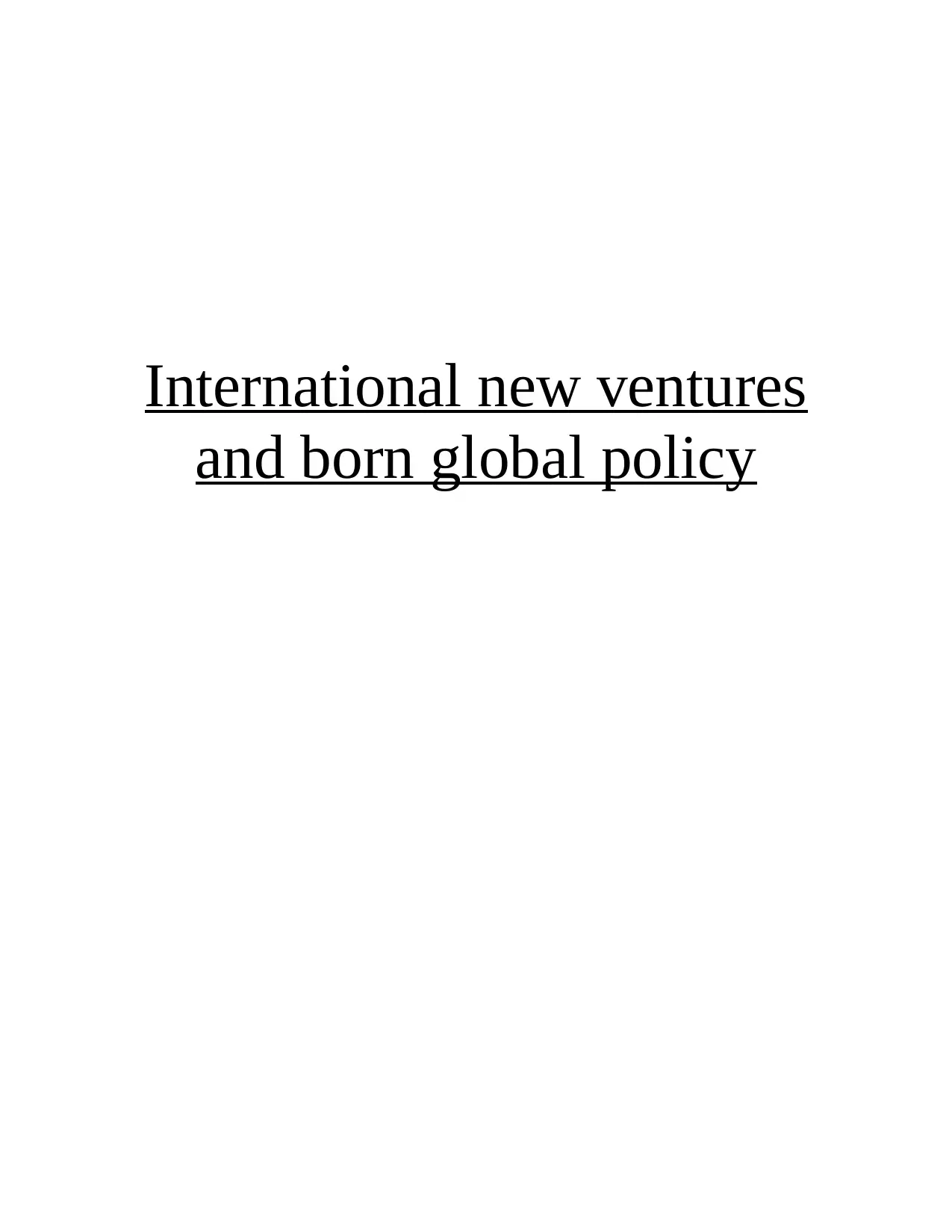
International new ventures
and born global policy
and born global policy
Paraphrase This Document
Need a fresh take? Get an instant paraphrase of this document with our AI Paraphraser
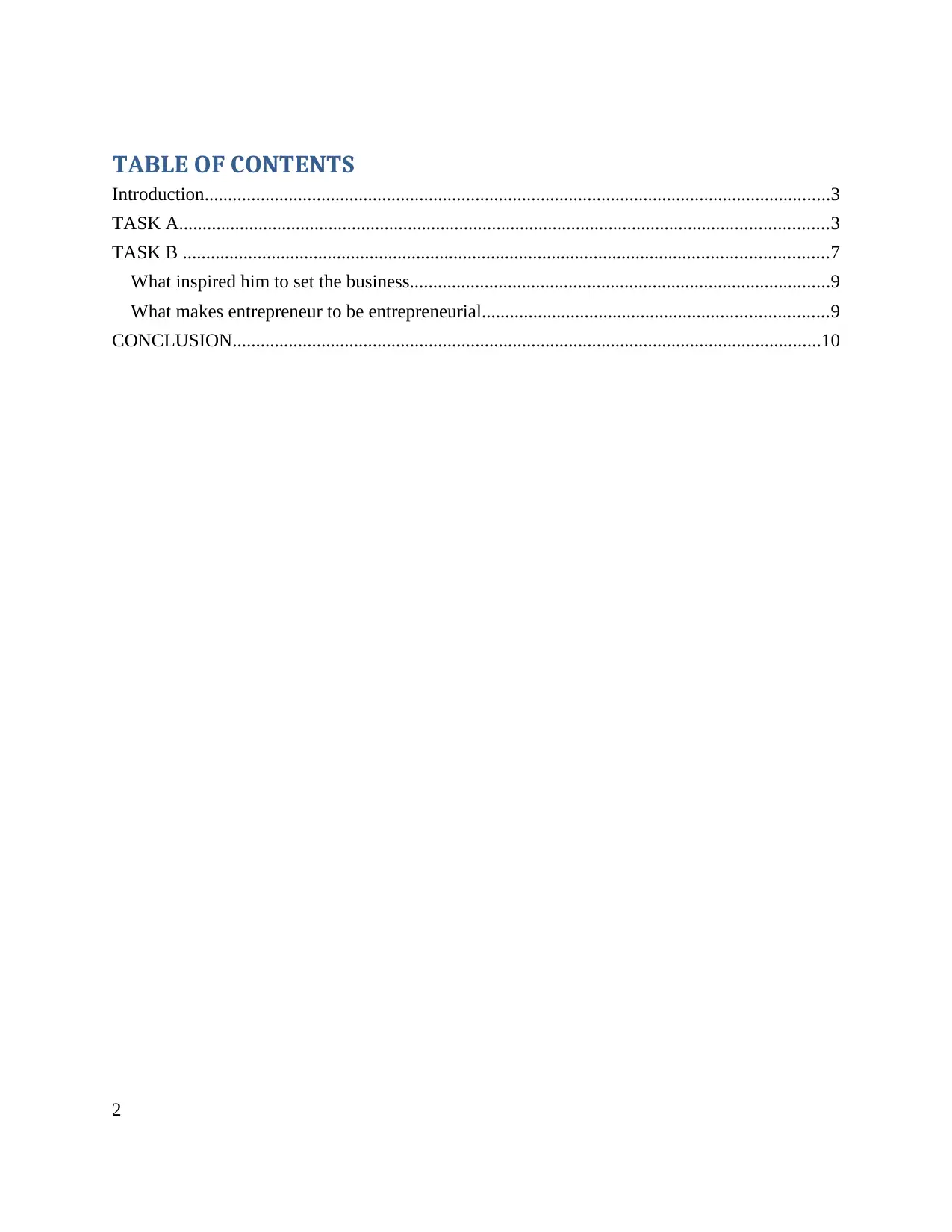
TABLE OF CONTENTS
Introduction......................................................................................................................................3
TASK A...........................................................................................................................................3
TASK B ..........................................................................................................................................7
What inspired him to set the business..........................................................................................9
What makes entrepreneur to be entrepreneurial..........................................................................9
CONCLUSION..............................................................................................................................10
2
Introduction......................................................................................................................................3
TASK A...........................................................................................................................................3
TASK B ..........................................................................................................................................7
What inspired him to set the business..........................................................................................9
What makes entrepreneur to be entrepreneurial..........................................................................9
CONCLUSION..............................................................................................................................10
2
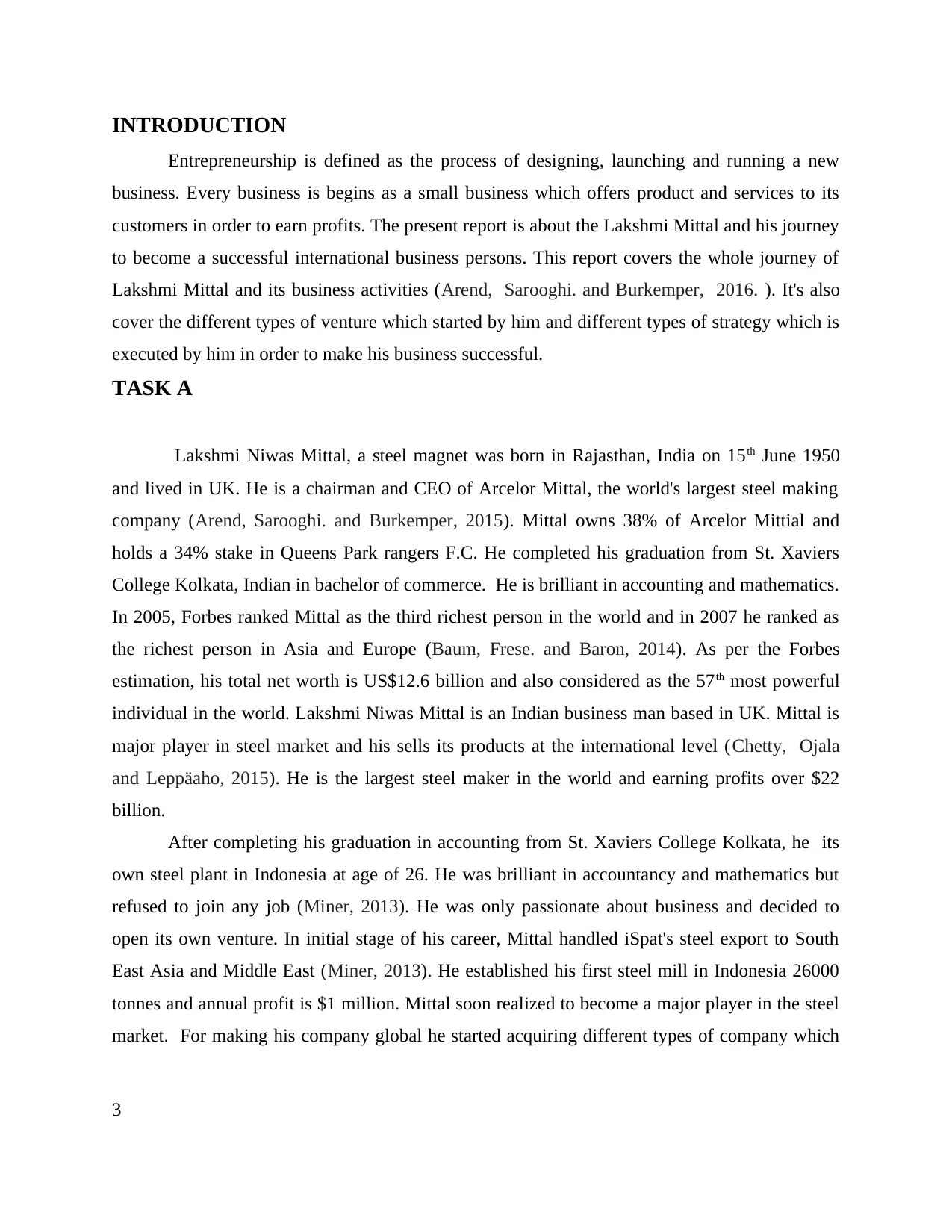
INTRODUCTION
Entrepreneurship is defined as the process of designing, launching and running a new
business. Every business is begins as a small business which offers product and services to its
customers in order to earn profits. The present report is about the Lakshmi Mittal and his journey
to become a successful international business persons. This report covers the whole journey of
Lakshmi Mittal and its business activities (Arend, Sarooghi. and Burkemper, 2016. ). It's also
cover the different types of venture which started by him and different types of strategy which is
executed by him in order to make his business successful.
TASK A
Lakshmi Niwas Mittal, a steel magnet was born in Rajasthan, India on 15th June 1950
and lived in UK. He is a chairman and CEO of Arcelor Mittal, the world's largest steel making
company (Arend, Sarooghi. and Burkemper, 2015). Mittal owns 38% of Arcelor Mittial and
holds a 34% stake in Queens Park rangers F.C. He completed his graduation from St. Xaviers
College Kolkata, Indian in bachelor of commerce. He is brilliant in accounting and mathematics.
In 2005, Forbes ranked Mittal as the third richest person in the world and in 2007 he ranked as
the richest person in Asia and Europe (Baum, Frese. and Baron, 2014). As per the Forbes
estimation, his total net worth is US$12.6 billion and also considered as the 57th most powerful
individual in the world. Lakshmi Niwas Mittal is an Indian business man based in UK. Mittal is
major player in steel market and his sells its products at the international level (Chetty, Ojala
and Leppäaho, 2015). He is the largest steel maker in the world and earning profits over $22
billion.
After completing his graduation in accounting from St. Xaviers College Kolkata, he its
own steel plant in Indonesia at age of 26. He was brilliant in accountancy and mathematics but
refused to join any job (Miner, 2013). He was only passionate about business and decided to
open its own venture. In initial stage of his career, Mittal handled iSpat's steel export to South
East Asia and Middle East (Miner, 2013). He established his first steel mill in Indonesia 26000
tonnes and annual profit is $1 million. Mittal soon realized to become a major player in the steel
market. For making his company global he started acquiring different types of company which
3
Entrepreneurship is defined as the process of designing, launching and running a new
business. Every business is begins as a small business which offers product and services to its
customers in order to earn profits. The present report is about the Lakshmi Mittal and his journey
to become a successful international business persons. This report covers the whole journey of
Lakshmi Mittal and its business activities (Arend, Sarooghi. and Burkemper, 2016. ). It's also
cover the different types of venture which started by him and different types of strategy which is
executed by him in order to make his business successful.
TASK A
Lakshmi Niwas Mittal, a steel magnet was born in Rajasthan, India on 15th June 1950
and lived in UK. He is a chairman and CEO of Arcelor Mittal, the world's largest steel making
company (Arend, Sarooghi. and Burkemper, 2015). Mittal owns 38% of Arcelor Mittial and
holds a 34% stake in Queens Park rangers F.C. He completed his graduation from St. Xaviers
College Kolkata, Indian in bachelor of commerce. He is brilliant in accounting and mathematics.
In 2005, Forbes ranked Mittal as the third richest person in the world and in 2007 he ranked as
the richest person in Asia and Europe (Baum, Frese. and Baron, 2014). As per the Forbes
estimation, his total net worth is US$12.6 billion and also considered as the 57th most powerful
individual in the world. Lakshmi Niwas Mittal is an Indian business man based in UK. Mittal is
major player in steel market and his sells its products at the international level (Chetty, Ojala
and Leppäaho, 2015). He is the largest steel maker in the world and earning profits over $22
billion.
After completing his graduation in accounting from St. Xaviers College Kolkata, he its
own steel plant in Indonesia at age of 26. He was brilliant in accountancy and mathematics but
refused to join any job (Miner, 2013). He was only passionate about business and decided to
open its own venture. In initial stage of his career, Mittal handled iSpat's steel export to South
East Asia and Middle East (Miner, 2013). He established his first steel mill in Indonesia 26000
tonnes and annual profit is $1 million. Mittal soon realized to become a major player in the steel
market. For making his company global he started acquiring different types of company which
3
⊘ This is a preview!⊘
Do you want full access?
Subscribe today to unlock all pages.

Trusted by 1+ million students worldwide
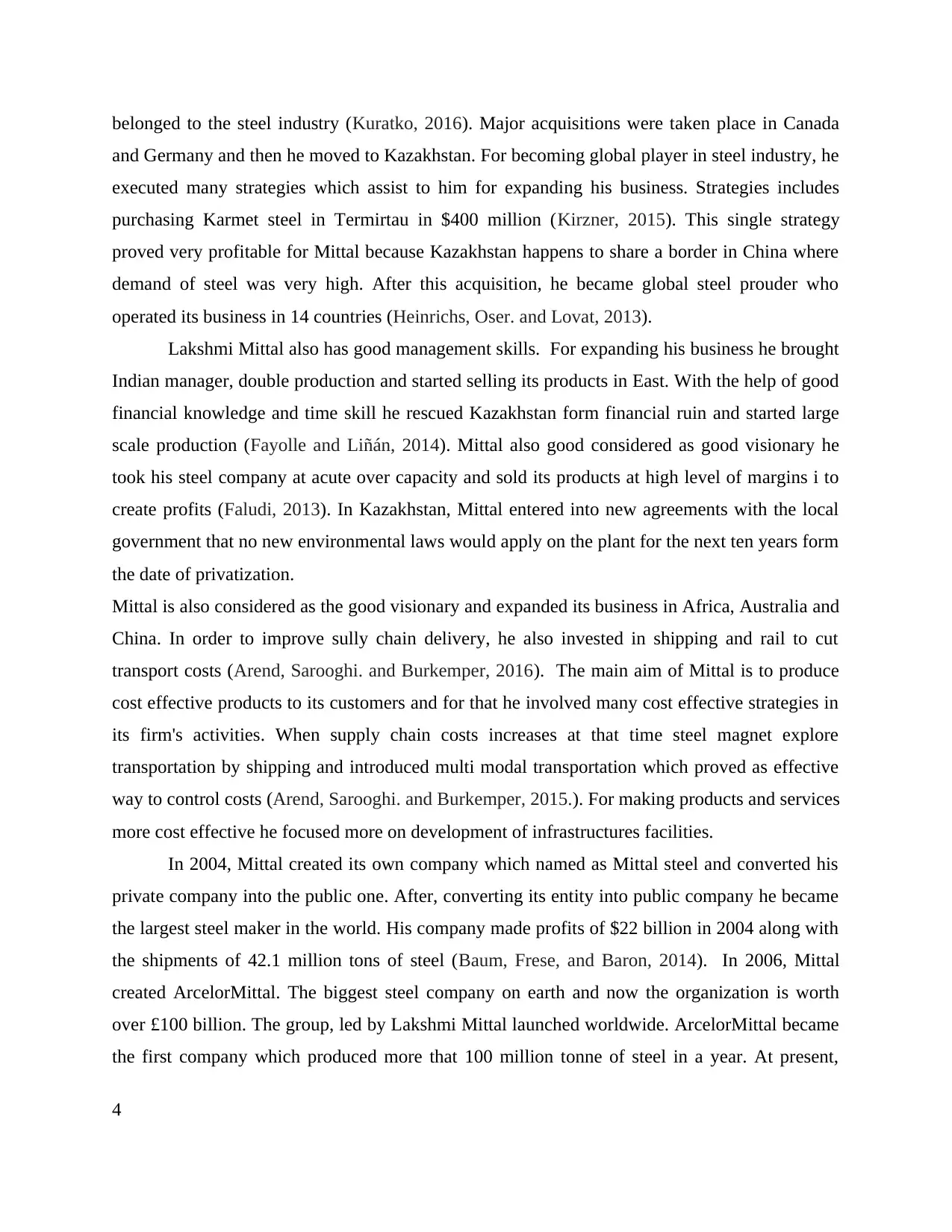
belonged to the steel industry (Kuratko, 2016). Major acquisitions were taken place in Canada
and Germany and then he moved to Kazakhstan. For becoming global player in steel industry, he
executed many strategies which assist to him for expanding his business. Strategies includes
purchasing Karmet steel in Termirtau in $400 million (Kirzner, 2015). This single strategy
proved very profitable for Mittal because Kazakhstan happens to share a border in China where
demand of steel was very high. After this acquisition, he became global steel prouder who
operated its business in 14 countries (Heinrichs, Oser. and Lovat, 2013).
Lakshmi Mittal also has good management skills. For expanding his business he brought
Indian manager, double production and started selling its products in East. With the help of good
financial knowledge and time skill he rescued Kazakhstan form financial ruin and started large
scale production (Fayolle and Liñán, 2014). Mittal also good considered as good visionary he
took his steel company at acute over capacity and sold its products at high level of margins i to
create profits (Faludi, 2013). In Kazakhstan, Mittal entered into new agreements with the local
government that no new environmental laws would apply on the plant for the next ten years form
the date of privatization.
Mittal is also considered as the good visionary and expanded its business in Africa, Australia and
China. In order to improve sully chain delivery, he also invested in shipping and rail to cut
transport costs (Arend, Sarooghi. and Burkemper, 2016). The main aim of Mittal is to produce
cost effective products to its customers and for that he involved many cost effective strategies in
its firm's activities. When supply chain costs increases at that time steel magnet explore
transportation by shipping and introduced multi modal transportation which proved as effective
way to control costs (Arend, Sarooghi. and Burkemper, 2015.). For making products and services
more cost effective he focused more on development of infrastructures facilities.
In 2004, Mittal created its own company which named as Mittal steel and converted his
private company into the public one. After, converting its entity into public company he became
the largest steel maker in the world. His company made profits of $22 billion in 2004 along with
the shipments of 42.1 million tons of steel (Baum, Frese, and Baron, 2014). In 2006, Mittal
created ArcelorMittal. The biggest steel company on earth and now the organization is worth
over £100 billion. The group, led by Lakshmi Mittal launched worldwide. ArcelorMittal became
the first company which produced more that 100 million tonne of steel in a year. At present,
4
and Germany and then he moved to Kazakhstan. For becoming global player in steel industry, he
executed many strategies which assist to him for expanding his business. Strategies includes
purchasing Karmet steel in Termirtau in $400 million (Kirzner, 2015). This single strategy
proved very profitable for Mittal because Kazakhstan happens to share a border in China where
demand of steel was very high. After this acquisition, he became global steel prouder who
operated its business in 14 countries (Heinrichs, Oser. and Lovat, 2013).
Lakshmi Mittal also has good management skills. For expanding his business he brought
Indian manager, double production and started selling its products in East. With the help of good
financial knowledge and time skill he rescued Kazakhstan form financial ruin and started large
scale production (Fayolle and Liñán, 2014). Mittal also good considered as good visionary he
took his steel company at acute over capacity and sold its products at high level of margins i to
create profits (Faludi, 2013). In Kazakhstan, Mittal entered into new agreements with the local
government that no new environmental laws would apply on the plant for the next ten years form
the date of privatization.
Mittal is also considered as the good visionary and expanded its business in Africa, Australia and
China. In order to improve sully chain delivery, he also invested in shipping and rail to cut
transport costs (Arend, Sarooghi. and Burkemper, 2016). The main aim of Mittal is to produce
cost effective products to its customers and for that he involved many cost effective strategies in
its firm's activities. When supply chain costs increases at that time steel magnet explore
transportation by shipping and introduced multi modal transportation which proved as effective
way to control costs (Arend, Sarooghi. and Burkemper, 2015.). For making products and services
more cost effective he focused more on development of infrastructures facilities.
In 2004, Mittal created its own company which named as Mittal steel and converted his
private company into the public one. After, converting its entity into public company he became
the largest steel maker in the world. His company made profits of $22 billion in 2004 along with
the shipments of 42.1 million tons of steel (Baum, Frese, and Baron, 2014). In 2006, Mittal
created ArcelorMittal. The biggest steel company on earth and now the organization is worth
over £100 billion. The group, led by Lakshmi Mittal launched worldwide. ArcelorMittal became
the first company which produced more that 100 million tonne of steel in a year. At present,
4
Paraphrase This Document
Need a fresh take? Get an instant paraphrase of this document with our AI Paraphraser
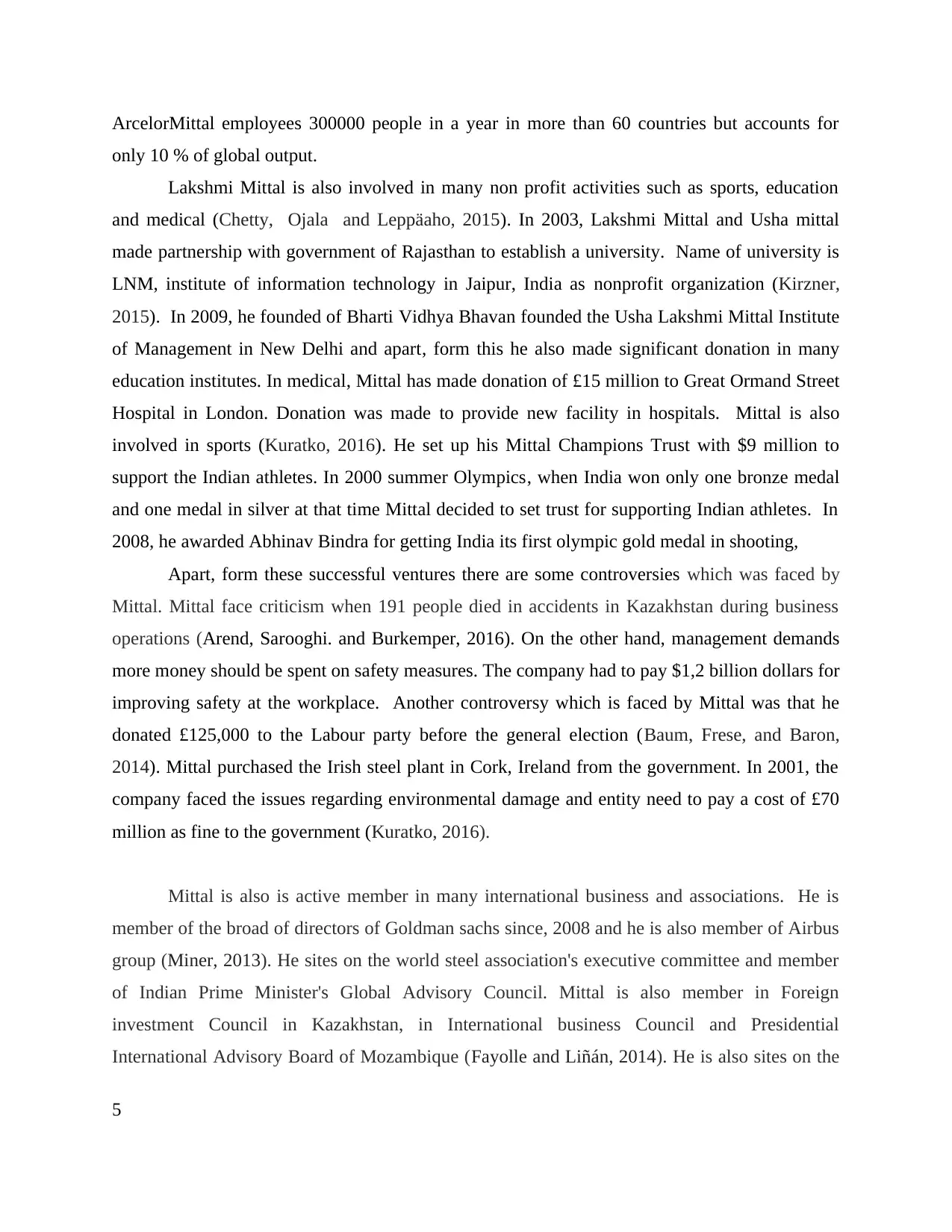
ArcelorMittal employees 300000 people in a year in more than 60 countries but accounts for
only 10 % of global output.
Lakshmi Mittal is also involved in many non profit activities such as sports, education
and medical (Chetty, Ojala and Leppäaho, 2015). In 2003, Lakshmi Mittal and Usha mittal
made partnership with government of Rajasthan to establish a university. Name of university is
LNM, institute of information technology in Jaipur, India as nonprofit organization (Kirzner,
2015). In 2009, he founded of Bharti Vidhya Bhavan founded the Usha Lakshmi Mittal Institute
of Management in New Delhi and apart, form this he also made significant donation in many
education institutes. In medical, Mittal has made donation of £15 million to Great Ormand Street
Hospital in London. Donation was made to provide new facility in hospitals. Mittal is also
involved in sports (Kuratko, 2016). He set up his Mittal Champions Trust with $9 million to
support the Indian athletes. In 2000 summer Olympics, when India won only one bronze medal
and one medal in silver at that time Mittal decided to set trust for supporting Indian athletes. In
2008, he awarded Abhinav Bindra for getting India its first olympic gold medal in shooting,
Apart, form these successful ventures there are some controversies which was faced by
Mittal. Mittal face criticism when 191 people died in accidents in Kazakhstan during business
operations (Arend, Sarooghi. and Burkemper, 2016). On the other hand, management demands
more money should be spent on safety measures. The company had to pay $1,2 billion dollars for
improving safety at the workplace. Another controversy which is faced by Mittal was that he
donated £125,000 to the Labour party before the general election (Baum, Frese, and Baron,
2014). Mittal purchased the Irish steel plant in Cork, Ireland from the government. In 2001, the
company faced the issues regarding environmental damage and entity need to pay a cost of £70
million as fine to the government (Kuratko, 2016).
Mittal is also is active member in many international business and associations. He is
member of the broad of directors of Goldman sachs since, 2008 and he is also member of Airbus
group (Miner, 2013). He sites on the world steel association's executive committee and member
of Indian Prime Minister's Global Advisory Council. Mittal is also member in Foreign
investment Council in Kazakhstan, in International business Council and Presidential
International Advisory Board of Mozambique (Fayolle and Liñán, 2014). He is also sites on the
5
only 10 % of global output.
Lakshmi Mittal is also involved in many non profit activities such as sports, education
and medical (Chetty, Ojala and Leppäaho, 2015). In 2003, Lakshmi Mittal and Usha mittal
made partnership with government of Rajasthan to establish a university. Name of university is
LNM, institute of information technology in Jaipur, India as nonprofit organization (Kirzner,
2015). In 2009, he founded of Bharti Vidhya Bhavan founded the Usha Lakshmi Mittal Institute
of Management in New Delhi and apart, form this he also made significant donation in many
education institutes. In medical, Mittal has made donation of £15 million to Great Ormand Street
Hospital in London. Donation was made to provide new facility in hospitals. Mittal is also
involved in sports (Kuratko, 2016). He set up his Mittal Champions Trust with $9 million to
support the Indian athletes. In 2000 summer Olympics, when India won only one bronze medal
and one medal in silver at that time Mittal decided to set trust for supporting Indian athletes. In
2008, he awarded Abhinav Bindra for getting India its first olympic gold medal in shooting,
Apart, form these successful ventures there are some controversies which was faced by
Mittal. Mittal face criticism when 191 people died in accidents in Kazakhstan during business
operations (Arend, Sarooghi. and Burkemper, 2016). On the other hand, management demands
more money should be spent on safety measures. The company had to pay $1,2 billion dollars for
improving safety at the workplace. Another controversy which is faced by Mittal was that he
donated £125,000 to the Labour party before the general election (Baum, Frese, and Baron,
2014). Mittal purchased the Irish steel plant in Cork, Ireland from the government. In 2001, the
company faced the issues regarding environmental damage and entity need to pay a cost of £70
million as fine to the government (Kuratko, 2016).
Mittal is also is active member in many international business and associations. He is
member of the broad of directors of Goldman sachs since, 2008 and he is also member of Airbus
group (Miner, 2013). He sites on the world steel association's executive committee and member
of Indian Prime Minister's Global Advisory Council. Mittal is also member in Foreign
investment Council in Kazakhstan, in International business Council and Presidential
International Advisory Board of Mozambique (Fayolle and Liñán, 2014). He is also sites on the
5
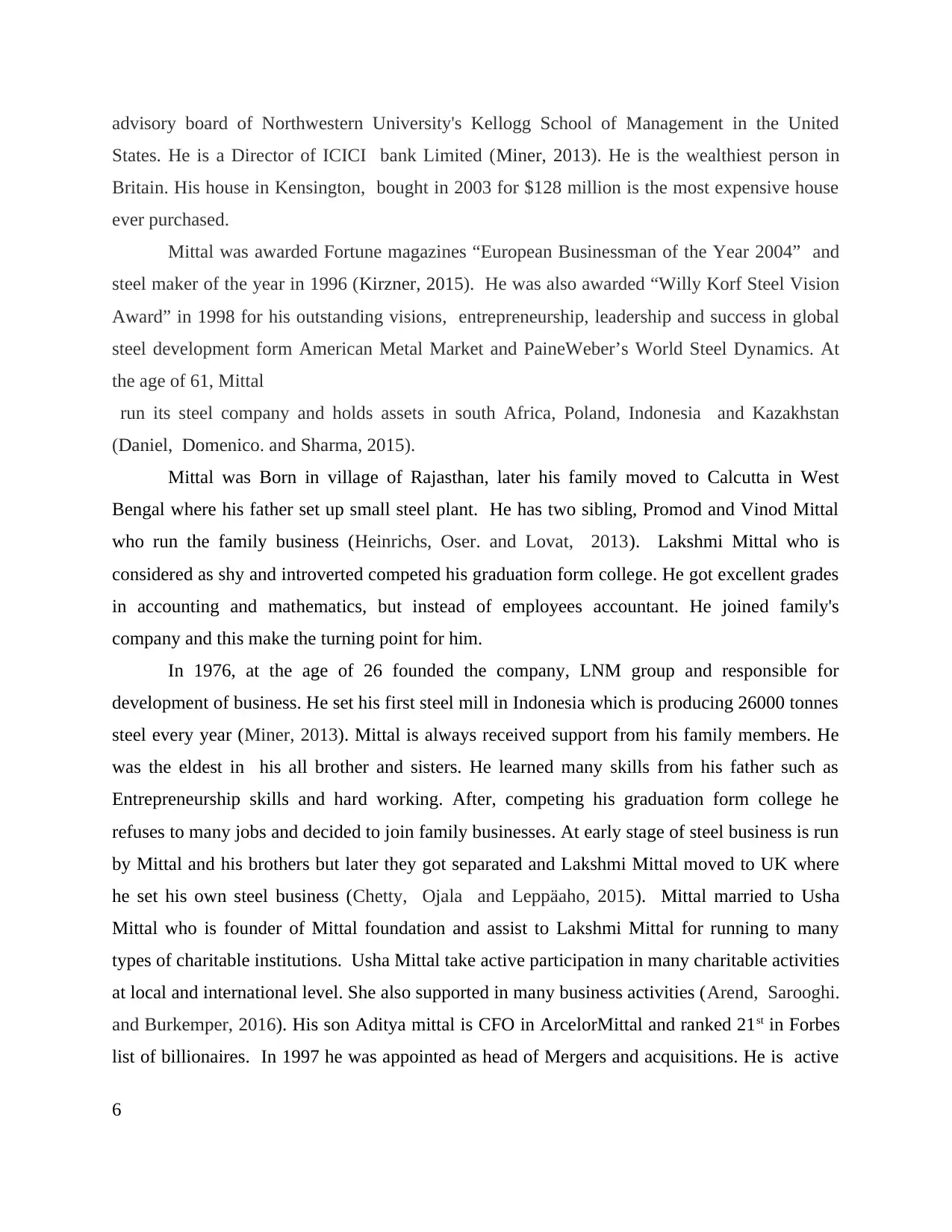
advisory board of Northwestern University's Kellogg School of Management in the United
States. He is a Director of ICICI bank Limited (Miner, 2013). He is the wealthiest person in
Britain. His house in Kensington, bought in 2003 for $128 million is the most expensive house
ever purchased.
Mittal was awarded Fortune magazines “European Businessman of the Year 2004” and
steel maker of the year in 1996 (Kirzner, 2015). He was also awarded “Willy Korf Steel Vision
Award” in 1998 for his outstanding visions, entrepreneurship, leadership and success in global
steel development form American Metal Market and PaineWeber’s World Steel Dynamics. At
the age of 61, Mittal
run its steel company and holds assets in south Africa, Poland, Indonesia and Kazakhstan
(Daniel, Domenico. and Sharma, 2015).
Mittal was Born in village of Rajasthan, later his family moved to Calcutta in West
Bengal where his father set up small steel plant. He has two sibling, Promod and Vinod Mittal
who run the family business (Heinrichs, Oser. and Lovat, 2013). Lakshmi Mittal who is
considered as shy and introverted competed his graduation form college. He got excellent grades
in accounting and mathematics, but instead of employees accountant. He joined family's
company and this make the turning point for him.
In 1976, at the age of 26 founded the company, LNM group and responsible for
development of business. He set his first steel mill in Indonesia which is producing 26000 tonnes
steel every year (Miner, 2013). Mittal is always received support from his family members. He
was the eldest in his all brother and sisters. He learned many skills from his father such as
Entrepreneurship skills and hard working. After, competing his graduation form college he
refuses to many jobs and decided to join family businesses. At early stage of steel business is run
by Mittal and his brothers but later they got separated and Lakshmi Mittal moved to UK where
he set his own steel business (Chetty, Ojala and Leppäaho, 2015). Mittal married to Usha
Mittal who is founder of Mittal foundation and assist to Lakshmi Mittal for running to many
types of charitable institutions. Usha Mittal take active participation in many charitable activities
at local and international level. She also supported in many business activities (Arend, Sarooghi.
and Burkemper, 2016). His son Aditya mittal is CFO in ArcelorMittal and ranked 21st in Forbes
list of billionaires. In 1997 he was appointed as head of Mergers and acquisitions. He is active
6
States. He is a Director of ICICI bank Limited (Miner, 2013). He is the wealthiest person in
Britain. His house in Kensington, bought in 2003 for $128 million is the most expensive house
ever purchased.
Mittal was awarded Fortune magazines “European Businessman of the Year 2004” and
steel maker of the year in 1996 (Kirzner, 2015). He was also awarded “Willy Korf Steel Vision
Award” in 1998 for his outstanding visions, entrepreneurship, leadership and success in global
steel development form American Metal Market and PaineWeber’s World Steel Dynamics. At
the age of 61, Mittal
run its steel company and holds assets in south Africa, Poland, Indonesia and Kazakhstan
(Daniel, Domenico. and Sharma, 2015).
Mittal was Born in village of Rajasthan, later his family moved to Calcutta in West
Bengal where his father set up small steel plant. He has two sibling, Promod and Vinod Mittal
who run the family business (Heinrichs, Oser. and Lovat, 2013). Lakshmi Mittal who is
considered as shy and introverted competed his graduation form college. He got excellent grades
in accounting and mathematics, but instead of employees accountant. He joined family's
company and this make the turning point for him.
In 1976, at the age of 26 founded the company, LNM group and responsible for
development of business. He set his first steel mill in Indonesia which is producing 26000 tonnes
steel every year (Miner, 2013). Mittal is always received support from his family members. He
was the eldest in his all brother and sisters. He learned many skills from his father such as
Entrepreneurship skills and hard working. After, competing his graduation form college he
refuses to many jobs and decided to join family businesses. At early stage of steel business is run
by Mittal and his brothers but later they got separated and Lakshmi Mittal moved to UK where
he set his own steel business (Chetty, Ojala and Leppäaho, 2015). Mittal married to Usha
Mittal who is founder of Mittal foundation and assist to Lakshmi Mittal for running to many
types of charitable institutions. Usha Mittal take active participation in many charitable activities
at local and international level. She also supported in many business activities (Arend, Sarooghi.
and Burkemper, 2016). His son Aditya mittal is CFO in ArcelorMittal and ranked 21st in Forbes
list of billionaires. In 1997 he was appointed as head of Mergers and acquisitions. He is active
6
⊘ This is a preview!⊘
Do you want full access?
Subscribe today to unlock all pages.

Trusted by 1+ million students worldwide
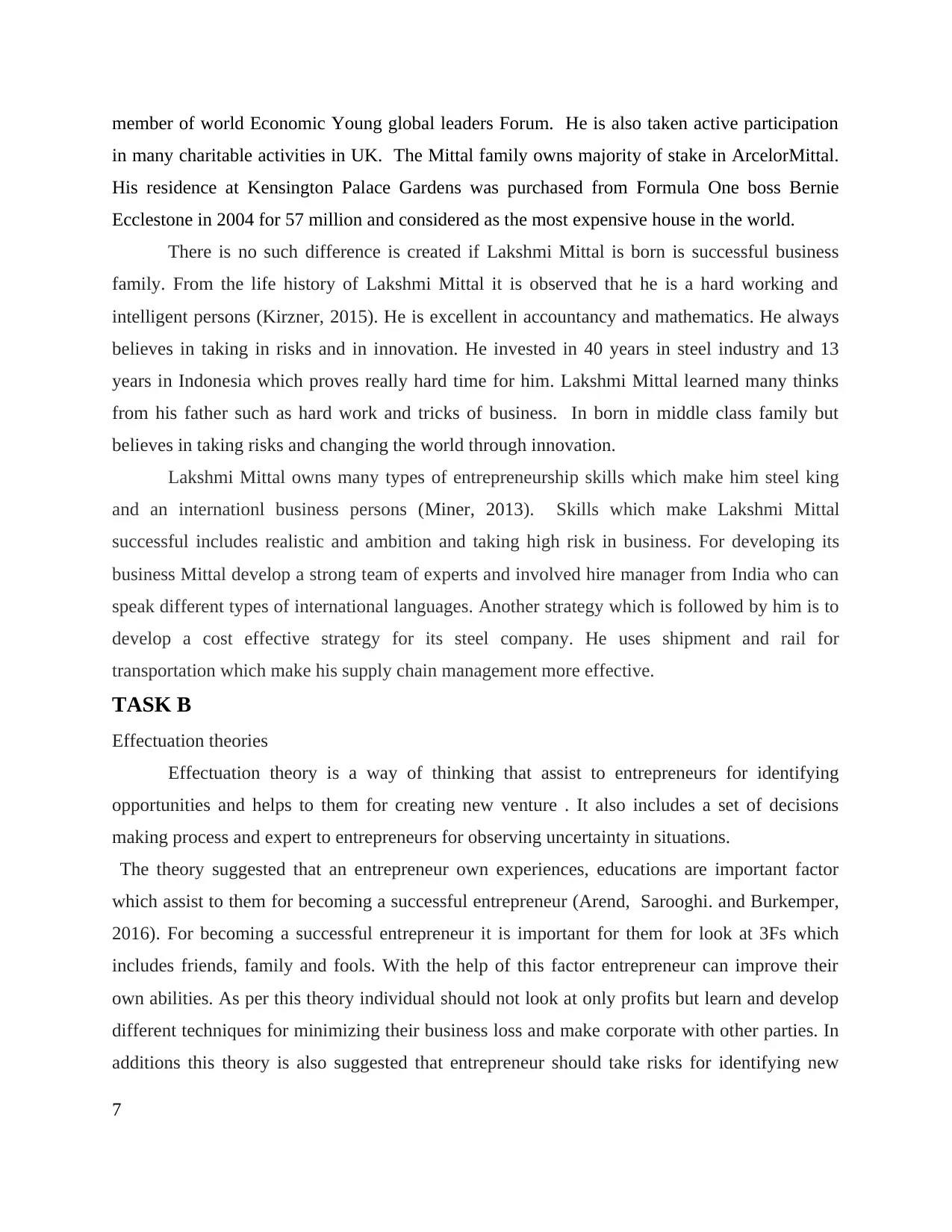
member of world Economic Young global leaders Forum. He is also taken active participation
in many charitable activities in UK. The Mittal family owns majority of stake in ArcelorMittal.
His residence at Kensington Palace Gardens was purchased from Formula One boss Bernie
Ecclestone in 2004 for 57 million and considered as the most expensive house in the world.
There is no such difference is created if Lakshmi Mittal is born is successful business
family. From the life history of Lakshmi Mittal it is observed that he is a hard working and
intelligent persons (Kirzner, 2015). He is excellent in accountancy and mathematics. He always
believes in taking in risks and in innovation. He invested in 40 years in steel industry and 13
years in Indonesia which proves really hard time for him. Lakshmi Mittal learned many thinks
from his father such as hard work and tricks of business. In born in middle class family but
believes in taking risks and changing the world through innovation.
Lakshmi Mittal owns many types of entrepreneurship skills which make him steel king
and an internationl business persons (Miner, 2013). Skills which make Lakshmi Mittal
successful includes realistic and ambition and taking high risk in business. For developing its
business Mittal develop a strong team of experts and involved hire manager from India who can
speak different types of international languages. Another strategy which is followed by him is to
develop a cost effective strategy for its steel company. He uses shipment and rail for
transportation which make his supply chain management more effective.
TASK B
Effectuation theories
Effectuation theory is a way of thinking that assist to entrepreneurs for identifying
opportunities and helps to them for creating new venture . It also includes a set of decisions
making process and expert to entrepreneurs for observing uncertainty in situations.
The theory suggested that an entrepreneur own experiences, educations are important factor
which assist to them for becoming a successful entrepreneur (Arend, Sarooghi. and Burkemper,
2016). For becoming a successful entrepreneur it is important for them for look at 3Fs which
includes friends, family and fools. With the help of this factor entrepreneur can improve their
own abilities. As per this theory individual should not look at only profits but learn and develop
different techniques for minimizing their business loss and make corporate with other parties. In
additions this theory is also suggested that entrepreneur should take risks for identifying new
7
in many charitable activities in UK. The Mittal family owns majority of stake in ArcelorMittal.
His residence at Kensington Palace Gardens was purchased from Formula One boss Bernie
Ecclestone in 2004 for 57 million and considered as the most expensive house in the world.
There is no such difference is created if Lakshmi Mittal is born is successful business
family. From the life history of Lakshmi Mittal it is observed that he is a hard working and
intelligent persons (Kirzner, 2015). He is excellent in accountancy and mathematics. He always
believes in taking in risks and in innovation. He invested in 40 years in steel industry and 13
years in Indonesia which proves really hard time for him. Lakshmi Mittal learned many thinks
from his father such as hard work and tricks of business. In born in middle class family but
believes in taking risks and changing the world through innovation.
Lakshmi Mittal owns many types of entrepreneurship skills which make him steel king
and an internationl business persons (Miner, 2013). Skills which make Lakshmi Mittal
successful includes realistic and ambition and taking high risk in business. For developing its
business Mittal develop a strong team of experts and involved hire manager from India who can
speak different types of international languages. Another strategy which is followed by him is to
develop a cost effective strategy for its steel company. He uses shipment and rail for
transportation which make his supply chain management more effective.
TASK B
Effectuation theories
Effectuation theory is a way of thinking that assist to entrepreneurs for identifying
opportunities and helps to them for creating new venture . It also includes a set of decisions
making process and expert to entrepreneurs for observing uncertainty in situations.
The theory suggested that an entrepreneur own experiences, educations are important factor
which assist to them for becoming a successful entrepreneur (Arend, Sarooghi. and Burkemper,
2016). For becoming a successful entrepreneur it is important for them for look at 3Fs which
includes friends, family and fools. With the help of this factor entrepreneur can improve their
own abilities. As per this theory individual should not look at only profits but learn and develop
different techniques for minimizing their business loss and make corporate with other parties. In
additions this theory is also suggested that entrepreneur should take risks for identifying new
7
Paraphrase This Document
Need a fresh take? Get an instant paraphrase of this document with our AI Paraphraser
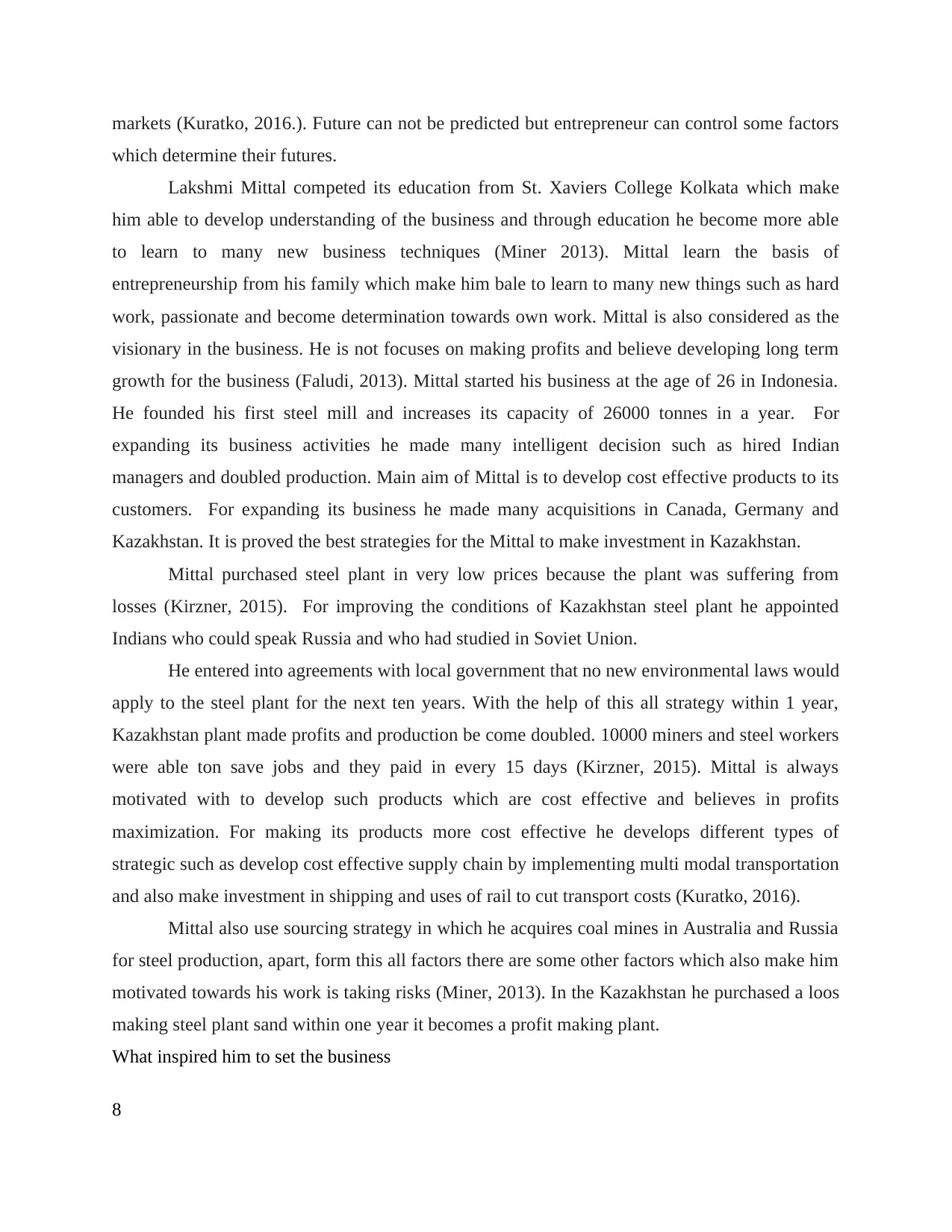
markets (Kuratko, 2016.). Future can not be predicted but entrepreneur can control some factors
which determine their futures.
Lakshmi Mittal competed its education from St. Xaviers College Kolkata which make
him able to develop understanding of the business and through education he become more able
to learn to many new business techniques (Miner 2013). Mittal learn the basis of
entrepreneurship from his family which make him bale to learn to many new things such as hard
work, passionate and become determination towards own work. Mittal is also considered as the
visionary in the business. He is not focuses on making profits and believe developing long term
growth for the business (Faludi, 2013). Mittal started his business at the age of 26 in Indonesia.
He founded his first steel mill and increases its capacity of 26000 tonnes in a year. For
expanding its business activities he made many intelligent decision such as hired Indian
managers and doubled production. Main aim of Mittal is to develop cost effective products to its
customers. For expanding its business he made many acquisitions in Canada, Germany and
Kazakhstan. It is proved the best strategies for the Mittal to make investment in Kazakhstan.
Mittal purchased steel plant in very low prices because the plant was suffering from
losses (Kirzner, 2015). For improving the conditions of Kazakhstan steel plant he appointed
Indians who could speak Russia and who had studied in Soviet Union.
He entered into agreements with local government that no new environmental laws would
apply to the steel plant for the next ten years. With the help of this all strategy within 1 year,
Kazakhstan plant made profits and production be come doubled. 10000 miners and steel workers
were able ton save jobs and they paid in every 15 days (Kirzner, 2015). Mittal is always
motivated with to develop such products which are cost effective and believes in profits
maximization. For making its products more cost effective he develops different types of
strategic such as develop cost effective supply chain by implementing multi modal transportation
and also make investment in shipping and uses of rail to cut transport costs (Kuratko, 2016).
Mittal also use sourcing strategy in which he acquires coal mines in Australia and Russia
for steel production, apart, form this all factors there are some other factors which also make him
motivated towards his work is taking risks (Miner, 2013). In the Kazakhstan he purchased a loos
making steel plant sand within one year it becomes a profit making plant.
What inspired him to set the business
8
which determine their futures.
Lakshmi Mittal competed its education from St. Xaviers College Kolkata which make
him able to develop understanding of the business and through education he become more able
to learn to many new business techniques (Miner 2013). Mittal learn the basis of
entrepreneurship from his family which make him bale to learn to many new things such as hard
work, passionate and become determination towards own work. Mittal is also considered as the
visionary in the business. He is not focuses on making profits and believe developing long term
growth for the business (Faludi, 2013). Mittal started his business at the age of 26 in Indonesia.
He founded his first steel mill and increases its capacity of 26000 tonnes in a year. For
expanding its business activities he made many intelligent decision such as hired Indian
managers and doubled production. Main aim of Mittal is to develop cost effective products to its
customers. For expanding its business he made many acquisitions in Canada, Germany and
Kazakhstan. It is proved the best strategies for the Mittal to make investment in Kazakhstan.
Mittal purchased steel plant in very low prices because the plant was suffering from
losses (Kirzner, 2015). For improving the conditions of Kazakhstan steel plant he appointed
Indians who could speak Russia and who had studied in Soviet Union.
He entered into agreements with local government that no new environmental laws would
apply to the steel plant for the next ten years. With the help of this all strategy within 1 year,
Kazakhstan plant made profits and production be come doubled. 10000 miners and steel workers
were able ton save jobs and they paid in every 15 days (Kirzner, 2015). Mittal is always
motivated with to develop such products which are cost effective and believes in profits
maximization. For making its products more cost effective he develops different types of
strategic such as develop cost effective supply chain by implementing multi modal transportation
and also make investment in shipping and uses of rail to cut transport costs (Kuratko, 2016).
Mittal also use sourcing strategy in which he acquires coal mines in Australia and Russia
for steel production, apart, form this all factors there are some other factors which also make him
motivated towards his work is taking risks (Miner, 2013). In the Kazakhstan he purchased a loos
making steel plant sand within one year it becomes a profit making plant.
What inspired him to set the business
8
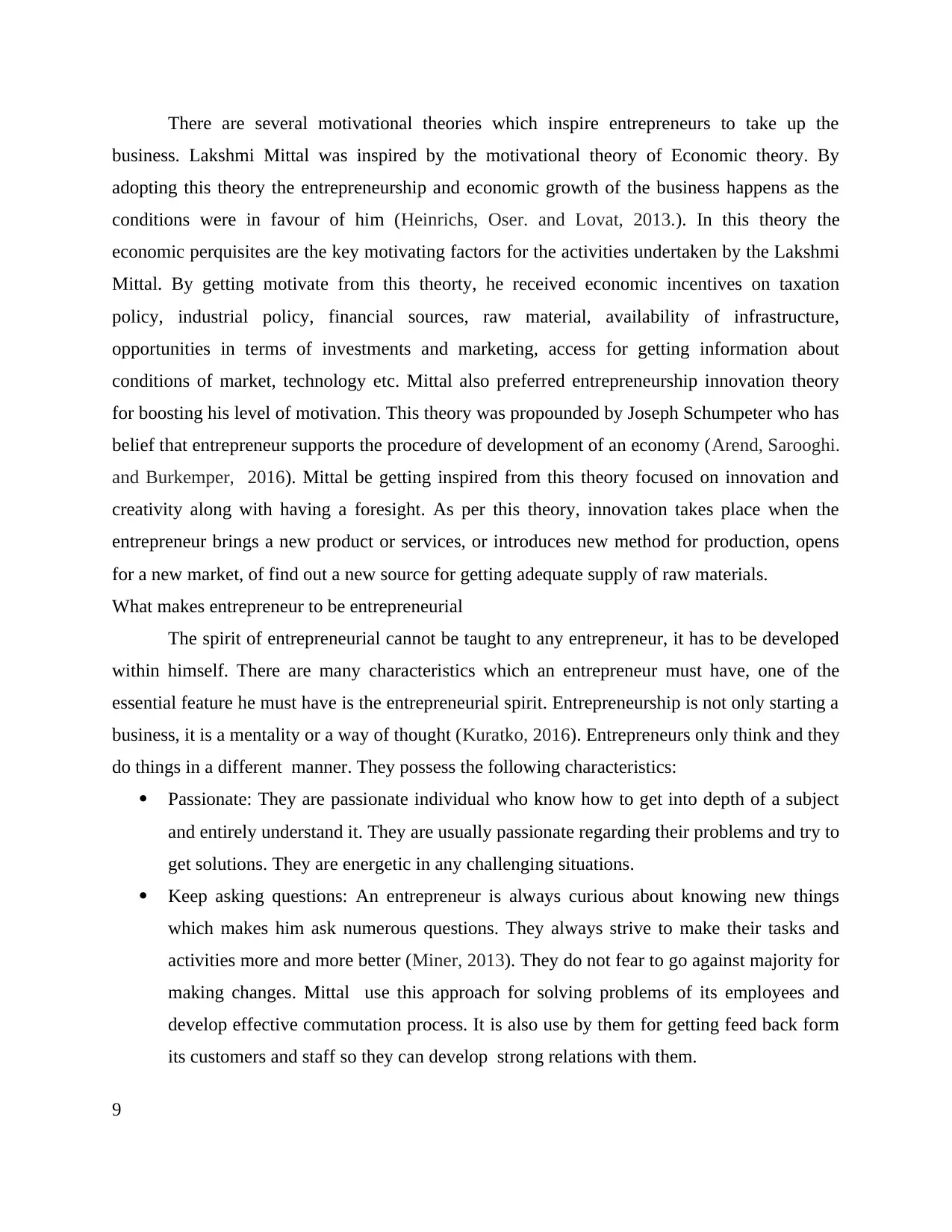
There are several motivational theories which inspire entrepreneurs to take up the
business. Lakshmi Mittal was inspired by the motivational theory of Economic theory. By
adopting this theory the entrepreneurship and economic growth of the business happens as the
conditions were in favour of him (Heinrichs, Oser. and Lovat, 2013.). In this theory the
economic perquisites are the key motivating factors for the activities undertaken by the Lakshmi
Mittal. By getting motivate from this theorty, he received economic incentives on taxation
policy, industrial policy, financial sources, raw material, availability of infrastructure,
opportunities in terms of investments and marketing, access for getting information about
conditions of market, technology etc. Mittal also preferred entrepreneurship innovation theory
for boosting his level of motivation. This theory was propounded by Joseph Schumpeter who has
belief that entrepreneur supports the procedure of development of an economy (Arend, Sarooghi.
and Burkemper, 2016). Mittal be getting inspired from this theory focused on innovation and
creativity along with having a foresight. As per this theory, innovation takes place when the
entrepreneur brings a new product or services, or introduces new method for production, opens
for a new market, of find out a new source for getting adequate supply of raw materials.
What makes entrepreneur to be entrepreneurial
The spirit of entrepreneurial cannot be taught to any entrepreneur, it has to be developed
within himself. There are many characteristics which an entrepreneur must have, one of the
essential feature he must have is the entrepreneurial spirit. Entrepreneurship is not only starting a
business, it is a mentality or a way of thought (Kuratko, 2016). Entrepreneurs only think and they
do things in a different manner. They possess the following characteristics:
Passionate: They are passionate individual who know how to get into depth of a subject
and entirely understand it. They are usually passionate regarding their problems and try to
get solutions. They are energetic in any challenging situations.
Keep asking questions: An entrepreneur is always curious about knowing new things
which makes him ask numerous questions. They always strive to make their tasks and
activities more and more better (Miner, 2013). They do not fear to go against majority for
making changes. Mittal use this approach for solving problems of its employees and
develop effective commutation process. It is also use by them for getting feed back form
its customers and staff so they can develop strong relations with them.
9
business. Lakshmi Mittal was inspired by the motivational theory of Economic theory. By
adopting this theory the entrepreneurship and economic growth of the business happens as the
conditions were in favour of him (Heinrichs, Oser. and Lovat, 2013.). In this theory the
economic perquisites are the key motivating factors for the activities undertaken by the Lakshmi
Mittal. By getting motivate from this theorty, he received economic incentives on taxation
policy, industrial policy, financial sources, raw material, availability of infrastructure,
opportunities in terms of investments and marketing, access for getting information about
conditions of market, technology etc. Mittal also preferred entrepreneurship innovation theory
for boosting his level of motivation. This theory was propounded by Joseph Schumpeter who has
belief that entrepreneur supports the procedure of development of an economy (Arend, Sarooghi.
and Burkemper, 2016). Mittal be getting inspired from this theory focused on innovation and
creativity along with having a foresight. As per this theory, innovation takes place when the
entrepreneur brings a new product or services, or introduces new method for production, opens
for a new market, of find out a new source for getting adequate supply of raw materials.
What makes entrepreneur to be entrepreneurial
The spirit of entrepreneurial cannot be taught to any entrepreneur, it has to be developed
within himself. There are many characteristics which an entrepreneur must have, one of the
essential feature he must have is the entrepreneurial spirit. Entrepreneurship is not only starting a
business, it is a mentality or a way of thought (Kuratko, 2016). Entrepreneurs only think and they
do things in a different manner. They possess the following characteristics:
Passionate: They are passionate individual who know how to get into depth of a subject
and entirely understand it. They are usually passionate regarding their problems and try to
get solutions. They are energetic in any challenging situations.
Keep asking questions: An entrepreneur is always curious about knowing new things
which makes him ask numerous questions. They always strive to make their tasks and
activities more and more better (Miner, 2013). They do not fear to go against majority for
making changes. Mittal use this approach for solving problems of its employees and
develop effective commutation process. It is also use by them for getting feed back form
its customers and staff so they can develop strong relations with them.
9
⊘ This is a preview!⊘
Do you want full access?
Subscribe today to unlock all pages.

Trusted by 1+ million students worldwide
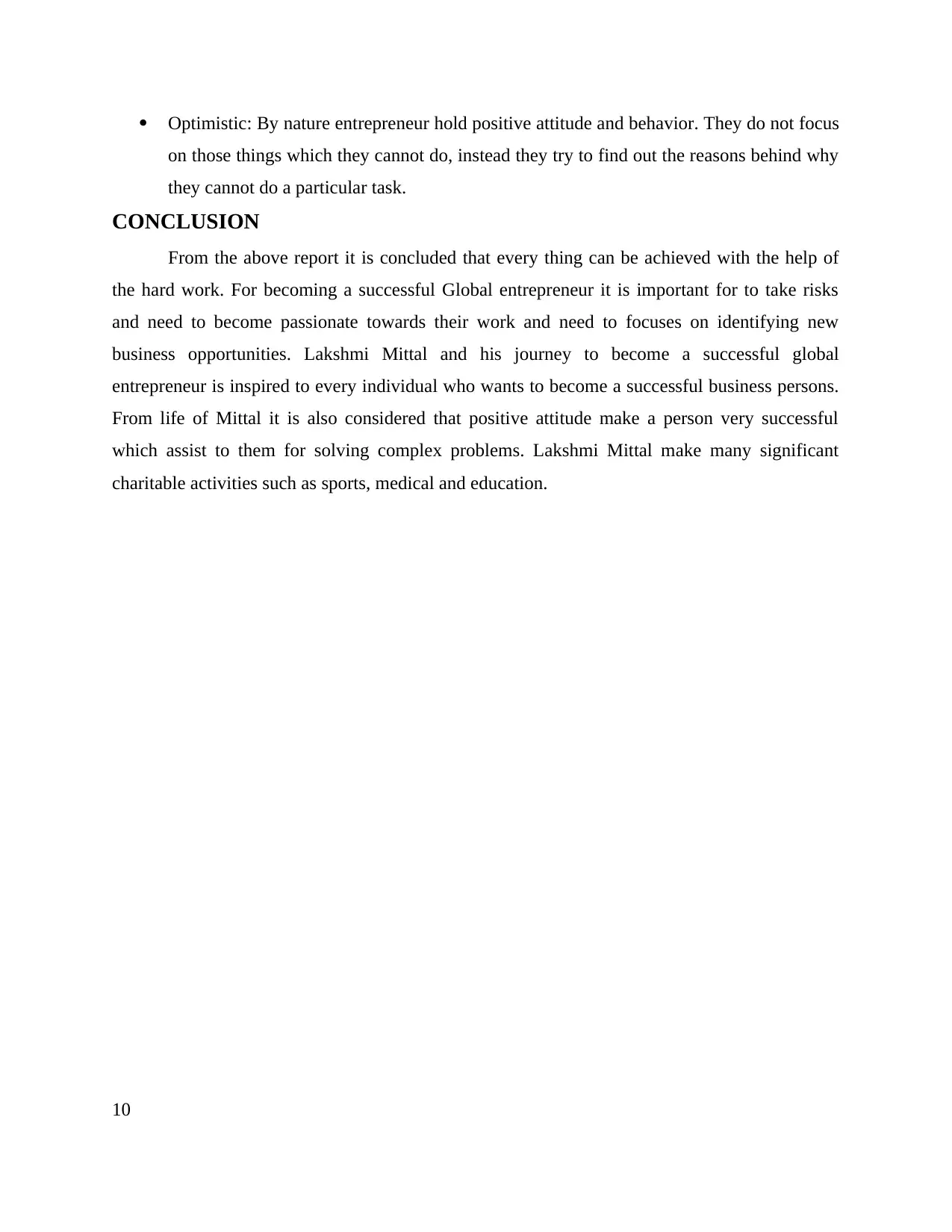
Optimistic: By nature entrepreneur hold positive attitude and behavior. They do not focus
on those things which they cannot do, instead they try to find out the reasons behind why
they cannot do a particular task.
CONCLUSION
From the above report it is concluded that every thing can be achieved with the help of
the hard work. For becoming a successful Global entrepreneur it is important for to take risks
and need to become passionate towards their work and need to focuses on identifying new
business opportunities. Lakshmi Mittal and his journey to become a successful global
entrepreneur is inspired to every individual who wants to become a successful business persons.
From life of Mittal it is also considered that positive attitude make a person very successful
which assist to them for solving complex problems. Lakshmi Mittal make many significant
charitable activities such as sports, medical and education.
10
on those things which they cannot do, instead they try to find out the reasons behind why
they cannot do a particular task.
CONCLUSION
From the above report it is concluded that every thing can be achieved with the help of
the hard work. For becoming a successful Global entrepreneur it is important for to take risks
and need to become passionate towards their work and need to focuses on identifying new
business opportunities. Lakshmi Mittal and his journey to become a successful global
entrepreneur is inspired to every individual who wants to become a successful business persons.
From life of Mittal it is also considered that positive attitude make a person very successful
which assist to them for solving complex problems. Lakshmi Mittal make many significant
charitable activities such as sports, medical and education.
10
Paraphrase This Document
Need a fresh take? Get an instant paraphrase of this document with our AI Paraphraser
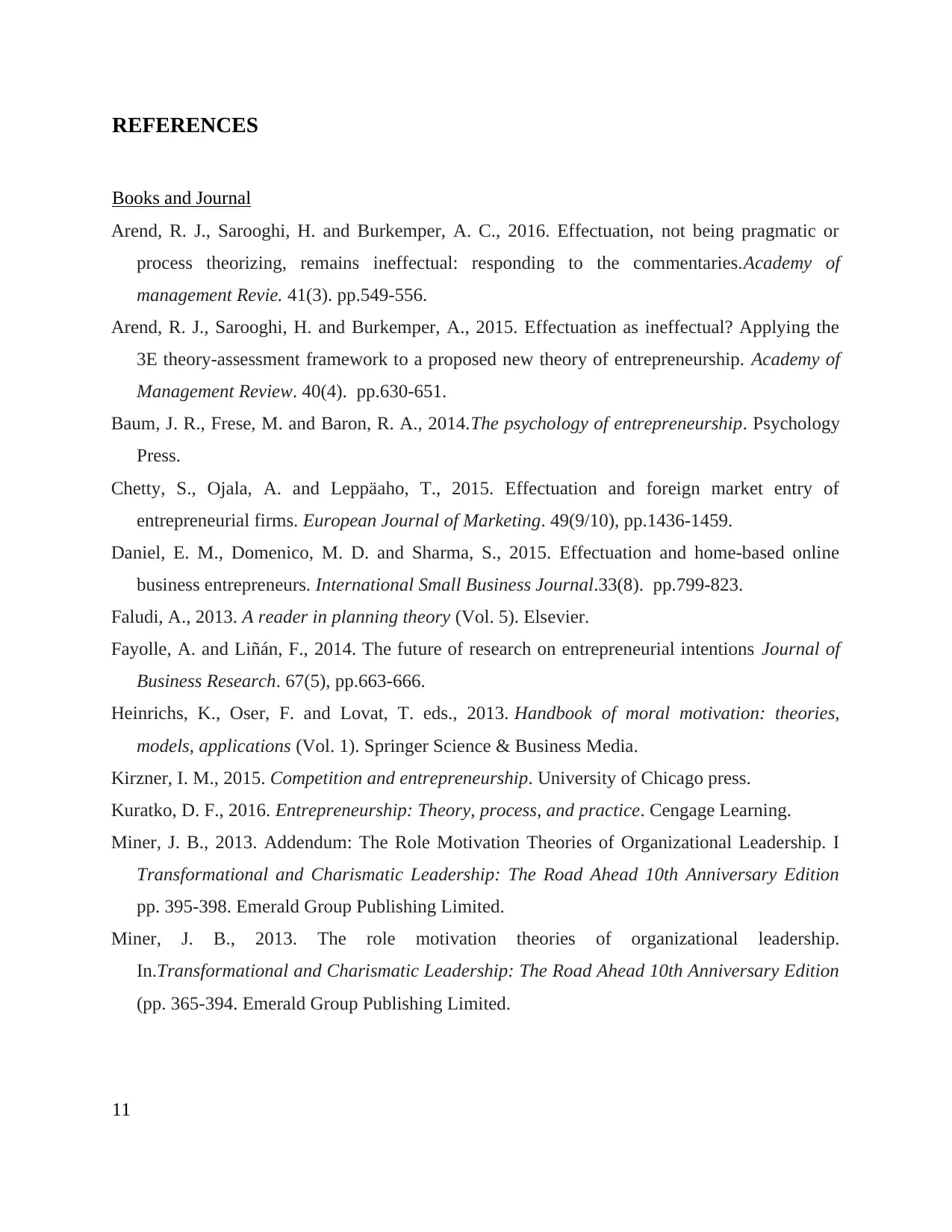
REFERENCES
Books and Journal
Arend, R. J., Sarooghi, H. and Burkemper, A. C., 2016. Effectuation, not being pragmatic or
process theorizing, remains ineffectual: responding to the commentaries.Academy of
management Revie. 41(3). pp.549-556.
Arend, R. J., Sarooghi, H. and Burkemper, A., 2015. Effectuation as ineffectual? Applying the
3E theory-assessment framework to a proposed new theory of entrepreneurship. Academy of
Management Review. 40(4). pp.630-651.
Baum, J. R., Frese, M. and Baron, R. A., 2014.The psychology of entrepreneurship. Psychology
Press.
Chetty, S., Ojala, A. and Leppäaho, T., 2015. Effectuation and foreign market entry of
entrepreneurial firms. European Journal of Marketing. 49(9/10), pp.1436-1459.
Daniel, E. M., Domenico, M. D. and Sharma, S., 2015. Effectuation and home-based online
business entrepreneurs. International Small Business Journal.33(8). pp.799-823.
Faludi, A., 2013. A reader in planning theory (Vol. 5). Elsevier.
Fayolle, A. and Liñán, F., 2014. The future of research on entrepreneurial intentions Journal of
Business Research. 67(5), pp.663-666.
Heinrichs, K., Oser, F. and Lovat, T. eds., 2013. Handbook of moral motivation: theories,
models, applications (Vol. 1). Springer Science & Business Media.
Kirzner, I. M., 2015. Competition and entrepreneurship. University of Chicago press.
Kuratko, D. F., 2016. Entrepreneurship: Theory, process, and practice. Cengage Learning.
Miner, J. B., 2013. Addendum: The Role Motivation Theories of Organizational Leadership. I
Transformational and Charismatic Leadership: The Road Ahead 10th Anniversary Edition
pp. 395-398. Emerald Group Publishing Limited.
Miner, J. B., 2013. The role motivation theories of organizational leadership.
In.Transformational and Charismatic Leadership: The Road Ahead 10th Anniversary Edition
(pp. 365-394. Emerald Group Publishing Limited.
11
Books and Journal
Arend, R. J., Sarooghi, H. and Burkemper, A. C., 2016. Effectuation, not being pragmatic or
process theorizing, remains ineffectual: responding to the commentaries.Academy of
management Revie. 41(3). pp.549-556.
Arend, R. J., Sarooghi, H. and Burkemper, A., 2015. Effectuation as ineffectual? Applying the
3E theory-assessment framework to a proposed new theory of entrepreneurship. Academy of
Management Review. 40(4). pp.630-651.
Baum, J. R., Frese, M. and Baron, R. A., 2014.The psychology of entrepreneurship. Psychology
Press.
Chetty, S., Ojala, A. and Leppäaho, T., 2015. Effectuation and foreign market entry of
entrepreneurial firms. European Journal of Marketing. 49(9/10), pp.1436-1459.
Daniel, E. M., Domenico, M. D. and Sharma, S., 2015. Effectuation and home-based online
business entrepreneurs. International Small Business Journal.33(8). pp.799-823.
Faludi, A., 2013. A reader in planning theory (Vol. 5). Elsevier.
Fayolle, A. and Liñán, F., 2014. The future of research on entrepreneurial intentions Journal of
Business Research. 67(5), pp.663-666.
Heinrichs, K., Oser, F. and Lovat, T. eds., 2013. Handbook of moral motivation: theories,
models, applications (Vol. 1). Springer Science & Business Media.
Kirzner, I. M., 2015. Competition and entrepreneurship. University of Chicago press.
Kuratko, D. F., 2016. Entrepreneurship: Theory, process, and practice. Cengage Learning.
Miner, J. B., 2013. Addendum: The Role Motivation Theories of Organizational Leadership. I
Transformational and Charismatic Leadership: The Road Ahead 10th Anniversary Edition
pp. 395-398. Emerald Group Publishing Limited.
Miner, J. B., 2013. The role motivation theories of organizational leadership.
In.Transformational and Charismatic Leadership: The Road Ahead 10th Anniversary Edition
(pp. 365-394. Emerald Group Publishing Limited.
11
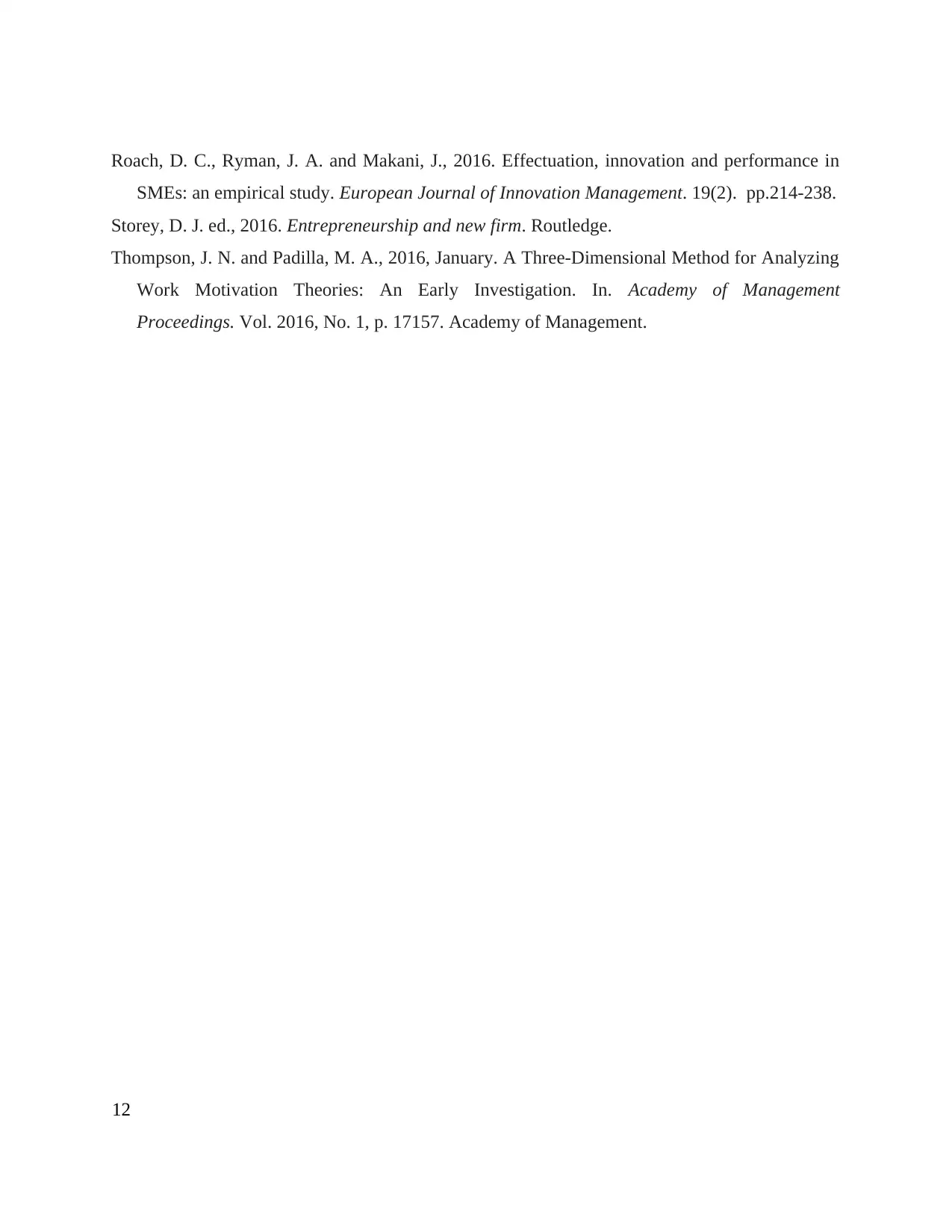
Roach, D. C., Ryman, J. A. and Makani, J., 2016. Effectuation, innovation and performance in
SMEs: an empirical study. European Journal of Innovation Management. 19(2). pp.214-238.
Storey, D. J. ed., 2016. Entrepreneurship and new firm. Routledge.
Thompson, J. N. and Padilla, M. A., 2016, January. A Three-Dimensional Method for Analyzing
Work Motivation Theories: An Early Investigation. In. Academy of Management
Proceedings. Vol. 2016, No. 1, p. 17157. Academy of Management.
12
SMEs: an empirical study. European Journal of Innovation Management. 19(2). pp.214-238.
Storey, D. J. ed., 2016. Entrepreneurship and new firm. Routledge.
Thompson, J. N. and Padilla, M. A., 2016, January. A Three-Dimensional Method for Analyzing
Work Motivation Theories: An Early Investigation. In. Academy of Management
Proceedings. Vol. 2016, No. 1, p. 17157. Academy of Management.
12
⊘ This is a preview!⊘
Do you want full access?
Subscribe today to unlock all pages.

Trusted by 1+ million students worldwide
1 out of 12
Your All-in-One AI-Powered Toolkit for Academic Success.
+13062052269
info@desklib.com
Available 24*7 on WhatsApp / Email
![[object Object]](/_next/static/media/star-bottom.7253800d.svg)
Unlock your academic potential
Copyright © 2020–2025 A2Z Services. All Rights Reserved. Developed and managed by ZUCOL.
